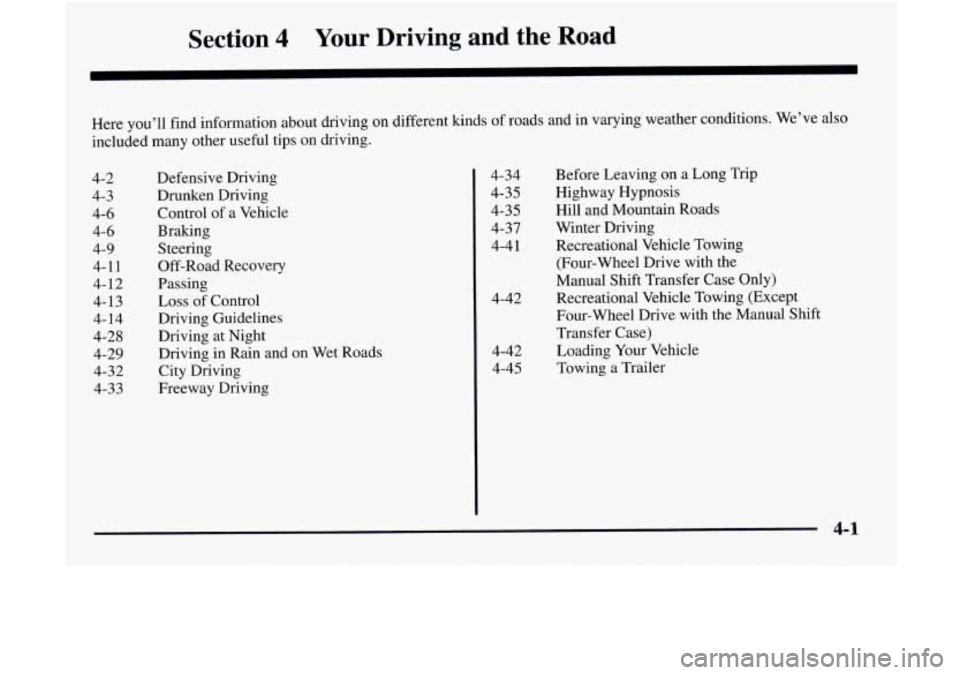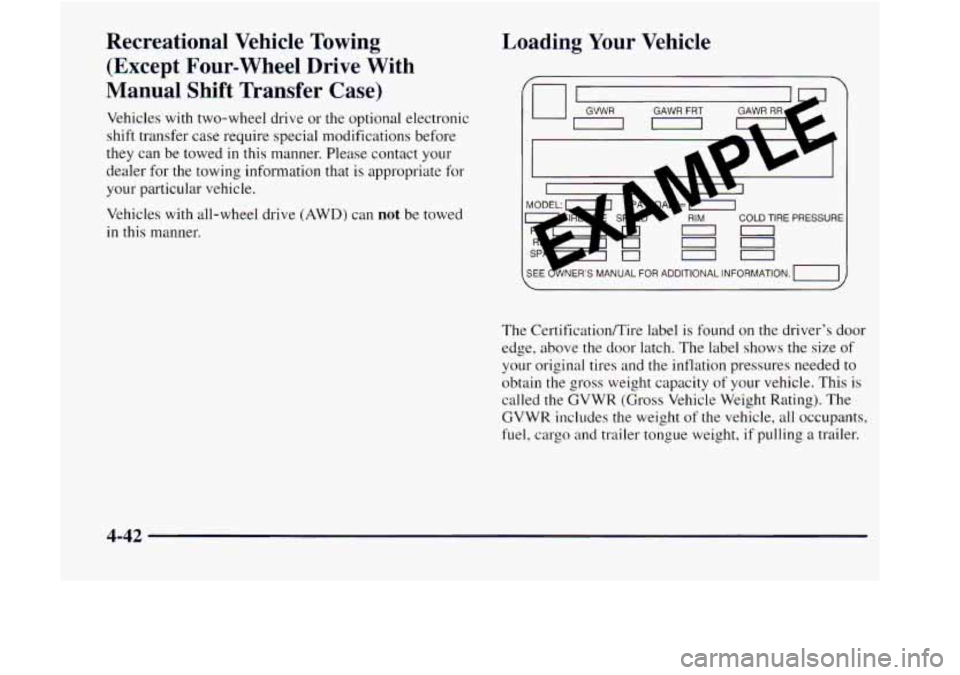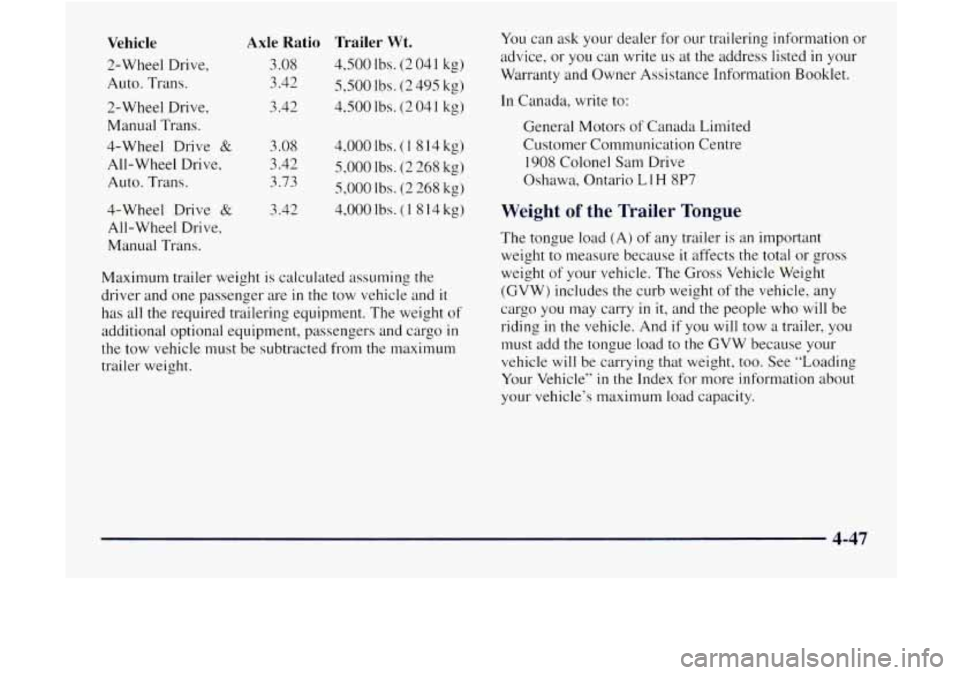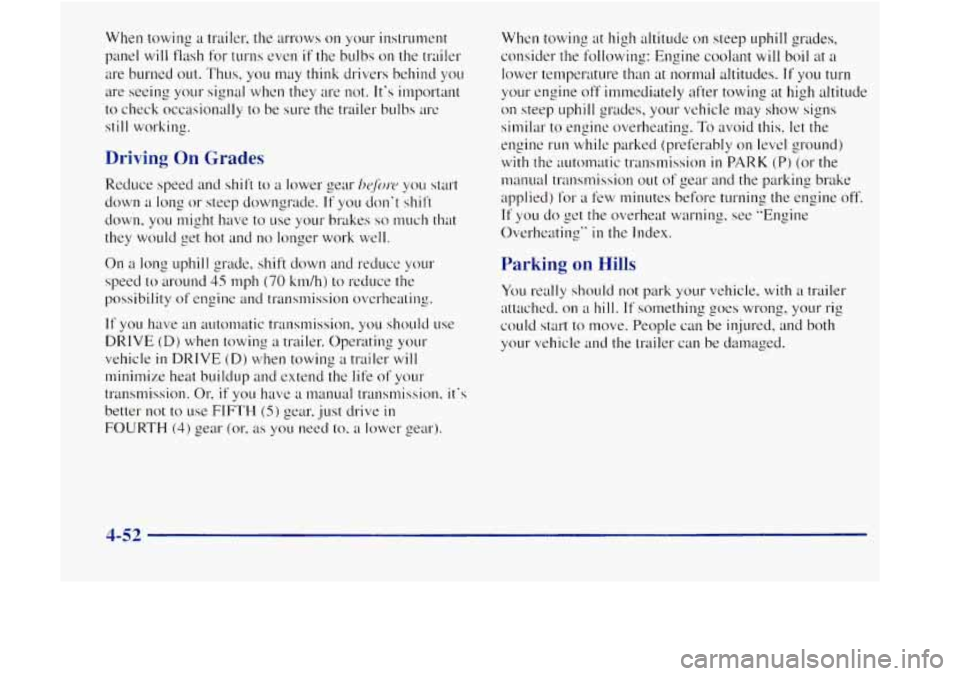tow GMC JIMMY 1997 Owner's Guide
[x] Cancel search | Manufacturer: GMC, Model Year: 1997, Model line: JIMMY, Model: GMC JIMMY 1997Pages: 410, PDF Size: 20.03 MB
Page 148 of 410

Defogging and Defrosting
On cool. humid days. use BLEND to keep the
windshield and side windows clear.
Use
DEFROST to remove fog or ice from the
windshield quickly
in extreme humid or cold conditions.
Turn the temperature knob clockwise and
move the fhn
control toward HI.
Rear Window Defogger (Option)
window of as much snow or ice as possible before using
the rear window defogger.
To turn on the rear window defogger, find the switch
marked REAR
DEFOG on your instrument panel below
the headlamp switch. Press ON until the light in the
switch comes
on, then release it. It will only work if the
ignition switch is turned to RUN.
The rear window defozger will stay
on for five to seven
minutes. then turn off.
If you need additional warming
time, turn
it on again. You can turn the defogger off at
any time by pressing OFF.
Do not attach a temporary vehicle license, tape or decals
across the defogger grid on the rear window.
NOTICE:
Don’t use a razor blade or something else sharp
on the inside
of the rear window. If you do, you
could cut or damage the warming grid, and the
repairs wouldn’t be covered
by your warranty.
3-5
Page 166 of 410

Section 4 Your Driving and the Road
Here you’ll find information about driving on different kinds\
of roads and in varying weather conditions. We’ve also
included many other useful tips
on driving.
4-2
4-3 4-6
4-6 4-9
4-11
4-12 4-13
4-14
4-28 4-29
4-32 4-3 3 Defensive Driving
Drunken Driving Control
of a Vehicle
Braking
Steering
Off-Road Recovery
Passing
Loss of Control
Driving Guidelines
Driving at Night
Driving in Rain and on Wet Roads
City Driving
Freeway Driving Before Leaving on a Long Trip
Highway Hypnosis
Hill and Mountain Roads
Winter Driving Recreational Vehicle Towing
(Four-wheel Drive with the
Manual Shift Transfer Case Only)
Recreational Vehicle Towing (Except
Four-wheel Drive with the Manual Shift
Transfer Case)
Loading Your Vehicle
Towing a Trailer
4-34
4-35
4-35
4-37 4-4
1
4-42
4-42 4-45
4-1
Page 206 of 410

Recreational Vehicle Towing (Four-wheel Drive With
7
Shift Transfer Case Only)
1.
2.
3.
3.
Set the par' * lg brake firmly.
Place an automatic transmission
in PARK (P) or a
manual transmission in FIRST ( I ).
Firmly attach the vehicle being towed to the tow
vehicle.
Do not tow the vehicle by the rear bumper
bar. Refer
to the hitch manufacturer's instructions.
Place the manual shift transfer case shift lever
in
NEUTRAL (N).
A CAUTION:
Shifting the transfer case into NEUTRAL (N) can
cause your vehicle to roll even if the transmission
is
in PARK (P), for an automatic transmission, or
if your vehicle is in gear, for a manual
transmission. You
or others could be injured.
Make sure the parking brake
is firmly set before
you shift the transfer case into
NEUTRAL (N).
5. Release the parking brake only after the vehicle
being towed is firmly attached
to the tow vehicle.
6. Insert the ignition key into the ignition switch and
turn
it one notch forward of the LOCK position. This
places the key
in the OFF position, which unlocks
the steering column while preventing battery drain.
Unlocking the steering column will allow
for proper
movement
of the front wheelshires during towing.
4-41
Page 207 of 410

Recreational Vehicle Towing (Except Four-wheel Drive With
Manual Shift Transfer Case) Loading Your Vehicle
Vehicles with
two-wheel drive or the optional electronic
shift transfer case require special modifications before
they can be towed
in this manner. Please contact your
dealer for the towing information that
is appropriate for
your particular vehicle.
Vehicles
with all-wheel drive (AWD) can not be towed
in this manner.
The Certification/Tire label is found on the driver’s door
edge, above the door latch. The label shows the size
of
your original tires and the inflation pressures needed to
obtain the gross weight capacity of your vehicle. This is
called the GVWR (Gross Vehicle Weight Rating). The
GVWR includes the weight
of the vehicle, all occupants,
fuel, cargo and trailer tongue weight,
if pulling a trailer.
4-42
Page 210 of 410

Towing a Trailer
If you don’t use the correct equipment and drive
properly, you can lose control when you pull a
trailer. For example, if the trailer
is too heavy, the
brakes may not work well
-- or even at all. You
and your passengers could be seriously in.jured.
Pull a trailer only
if you have followed all the
steps in this section.
Ask your GR/I dealer for
advice and information about towing a trailer with vour vehicle.
I NOTICE:
Pulling a trailer improperly can damage your
vehicle and result in costly repairs not covered
by
your warranty. To pull a trailer correctly, follow
the advice in this part, and see your
GM dealer
for important information about towing
a trailer
with your vehicle.
Every vehicle
is ready for some trailer towing. If yours
was built
with trailering options, as many are. it‘s ready
for heavier trailers.
But trailering is different than just
driving your vehicle by itself. Trailering means changes
in handling, durability and fuel economy. Successful,
safe trailering takes correct equipment, and
it has to be
used properly.
That’s the reason for this part. In
it are many
time-tested, important trailering tips and safety rules.
Many
of these are important for your safety and that of
your passengers.
So please read this section carefully
before you pull a trailer.
4-45
Page 211 of 410

If You Do Decide To Pull A Trailer
If you do, here are some important points:
0
0
0
0
There are many different laws, including speed limit
restrictions, having to do with trailering. Make sure
your rig
will be legal, not only where you live but
also where you’ll be driving.
A good source for this
information can be state or provincial police.
Consider using a sway control
if your trailer will
weigh
2,000 lbs. (900 kg) or less. You should always
use a sway control
if your trailer will weigh more
than
2,000 lbs. (900 kg). You can ask a hitch dealer
about sway controls.
Don’t tow a trailer at all during the first
500 miles
(800 km) your new vehicle is driven. Your engine,
axle or other parts could be damaged.
Then, during the first
500 miles (800 km) that you
tow a trailer, don’t drive over
50 mph (80 km/h) and
don’t nuke starts at
full throttle. This helps your
engine and other parts
of your vehicle wear in at the
heavier loads.
If you have an automatic transmission, you can use
DRIVE
(D) (or, as you need to, a lower gear) when
towing
a trailer. Operating your vehicle in
DRIVE (D) when towing a trailer will minimize heat
buildup and extend the life
of your transmission. If
you have a manual transmission and you are towing
a trailer, it‘s better not to use FIFTH (5) gear. Just
drive
in FOURTH (4) gear (or, as you need to, a
lower gear).
Three important considerations have to do
with weight:
the weight of the trailer,
0 the weight of the trailer tongue
and the weight on your vehicle’s tires.
Weight of the Trailer
How heavy can a trailer safely be?
It depends on how you plan to use your rig. For
example, speed, altitude, road grades, outside
temperature and how much your vehicle
is used to pull a
trailer are all important. And,
it can also depend on any
special equipment that you have on your vehicle.
The following chart shows how much your trailer can
weigh, based upon your vehicle model and options.
4-46
Page 212 of 410

Vehicle
2-Wheel Drive,
Auto. Trans.
2- Wheel Drive,
Manual Trans.
4-Wheel Drive
&
All-Wheel Drive. Auto. Trans.
4-Wheel Drive
&
All-Wheel Drive,
Manual Trans.
Axle Ratio Trailer Wt.
3.08 4,500 lbs. (2 04 1 kg)
3.42 5,500 lbs. (2 495 kg)
3.42 4,500 Ibs. (2 04
1 kg)
3.08
3.42
3.73
3.42 4,000
lbs.
(1 8 14 kg)
5,000 Ibs. (2 268 kg)
5,000 Ibs.
(2 268 kg)
4,000 lbs.
( 1 8 14 kg)
Maximum trailer weight is calculated assuming the
driver and one passenger are
in the tow vehicle and it
has all the required trailering equipment. The weight of
additional optional equipment, passengers and cargo
in
the tow vehicle must be subtracted from the maximum
trailer weight. You
can ask your dealer for our trailering information or
advice, or you can write us at the address listed
in your
Warranty and Owner Assistance Information Booklet.
In Canada, write to:
General Motors of Canada Limited
Customer Communication Centre
1908 Colonel Sam Drive
Oshawa, Ontario
LI H 8P7
Weight of the Trailer Tongue
The tongue load (A) of any trailer is an important
weight to measure because
it affects the total or gross
weight of your vehicle. The Gross Vehicle Weight
(GVW) includes the curb weight of the vehicle, any
cargo you may carry
in it, and the people who will be
riding
in the vehicle. And if you will tow a trailer, you
must add the tongue load to the GVW because your
vehicle
will be carrying that weight, too. See ”Loading
Your Vehicle”
in the Index for more information about
your vehicle’s maximum load capacity.
4-47
Page 215 of 410

Driving with a Trailer
1 CAUTION:
If you have a rear-most window open and you
pull a trailer with your vehicle, carbon nlonoxide
(CO) could corne into your vehicle. You can’t see
or smell CO. It can cause unconsciousness or
death. (See “Engine Exhaust” in the Index.)
To
maximize your safety when towing a trailer:
Have your exhaust system inspected for
leaks, and make necessary repairs before
starting
on your trip.
Keep the rear-most windows closed.
If exhaust does come into your vehicle
through a window in the rear or another
opening, drive with your front, main
heating
or cooling system on and with the
fan on any speed.
This will bring fresh,
outside air into your vehicle. Do not use
MAX AX because it only recirculates the
air inside your vehicle. (See “ Comfort
Controls” in the Index.)
4-50
Page 216 of 410

Following Distance
Backing
Up
Making Turns
NOTICE:
Making very sharp turns while trailering could
cause the trailer to come
in contact with the
vehicle.
Your vehicle could be damaged. Avoid
making very sharp turns while trailering.
Turn Signals When Towing a Trailer
4-51
Page 217 of 410

When towing a trailer, the ~~rrows on your instrument
panel
will flash for turns even if the bulbs on the trailer
itre burned out. Thus. you may think drivers behind you
are seeing your signal when they are not. It's important
to check occasionally to be sure the trailer bulbs arc
still working.
Driving On Grades
On a long uphill grade, shift down and reducc your
speed
to around 45 mph (70 km/h) to reduce the
possibility
of engine and transmission ovc.rheating.
If you have an automatic transmission. you should use
DRIVE
(D) when towing a trailer. Operating your
vehicle
in DRIVE (D) when towing a trailer will
minimize heat buildup and extend the life
of your
trrmsmission. Or:
if you have ;1 manual transmission. it's
better not to use FIFTH (5) gear. just drive in
FOURTH (4) gear (or, as you need to, a I~MW gear). Whcn
towins at high altitude
on steep uphill grades,
consider the following: Engine coolant will boil at a
lower temperature than at normal altitudes. If yo^^ turn
your engine off immediately after towing
at high altitude
on steep uphill grades, your \:ellicle may show signs
similar to engine overheating.
To avoid this. let the
engine
r~~n while parked (preferably on level grout1d)
with the automatic transmission in PARK (Pj (or the
1manuaI transmission out of
gear and the parking brake
applied) 1'01-
;I few minutes before turning the engine off.
If you do get the overheat warning. see "Engine
Overheating"
in the Index.
Parking on Hills
You really should not park your vehicle. with a trailer
attached.
on a hill. If something goes wrong, your rig
could start
to move. People can be injured, and both
yo~~r vehicle and the trailer can
be damaged.
4-52